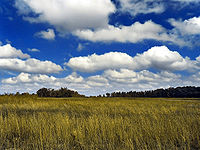
Photo from wikipedia
Abstract. A subset of continental shallow convective Cumulus (Cu) cloud fields were shown to have unique spatial properties and to form mostly over forests and vegetated areas, thus referred to… Click to show full abstract
Abstract. A subset of continental shallow convective Cumulus (Cu) cloud fields were shown to have unique spatial properties and to form mostly over forests and vegetated areas, thus referred to as green Cu. Green Cu fields are known to form organized mesoscale patterns, yet the underlying mechanisms as well as the time variability of these patterns are still lacking understanding. Here, we characterize the organization of green Cu in space and time, by using data driven organization metrics, and by applying an Empirical Orthogonal Function (EOF) analysis to a high-resolution GOES–16 dataset. We extract, quantify and reveal modes of organization present in a green Cu field, during the course of a day. The EOF decomposition is able to show the field's key organization features such as cloud streets, and it also delineates the less visible ones, as the propagation of gravity waves (GW), and the emergence of a highly organized grid on a spatial scale of hundreds of kilometers, over a time period that scales with the field's lifetime. Using cloud fields that were reconstructed from different subgroups of modes, we quantify the cloud street's wavelength and aspect ratio, as well as the GW dominant period.
Journal Title: Atmospheric Chemistry and Physics
Year Published: 2021
Link to full text (if available)
Share on Social Media: Sign Up to like & get
recommendations!